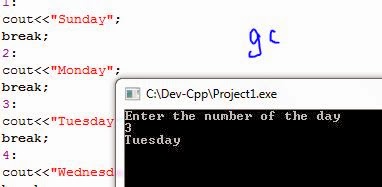Let me first clear up the aim. User enters a number from 1 to 7 and we output corresponding day, where 1 is Sunday and 7 is Saturday. We here use 'switch' statement, the syntax of which is given:
statement(s);
break;
case constant - 1:
statement(s);
break;
.
.
.
case constant - (n-1):
statement(s);
break;
default:
statement(s);
}
Code:
We just input the number from the user, and output corresponding days using switch statement. Switch statement is just like an if-else statement.
Sample output of the above program is:
Happy Coding!
:)
switch(expression){case constant - 0:
statement(s);
break;
case constant - 1:
statement(s);
break;
.
.
.
case constant - (n-1):
statement(s);
break;
default:
statement(s);
}
Code:
#include<iostream>
#include "conio.h";
using namespace std;
int main()
{
int ch;
cout<<"Enter the number of the day\n";
cin>>ch;
switch(ch)
{
case 1:
cout<<"Sunday";
break;
case 2:
cout<<"Monday";
break;
case 3:
cout<<"Tuesday";
break;
case 4:
cout<<"Wednesday";
break;
case 5:
cout<<"Thursday";
break;
case 6:
cout<<"Friday";
break;
case 7:
cout<<"Saturday";
break;
}
getch();
}
Working:We just input the number from the user, and output corresponding days using switch statement. Switch statement is just like an if-else statement.
Sample output of the above program is:
Happy Coding!
:)





No comments:
Post a Comment